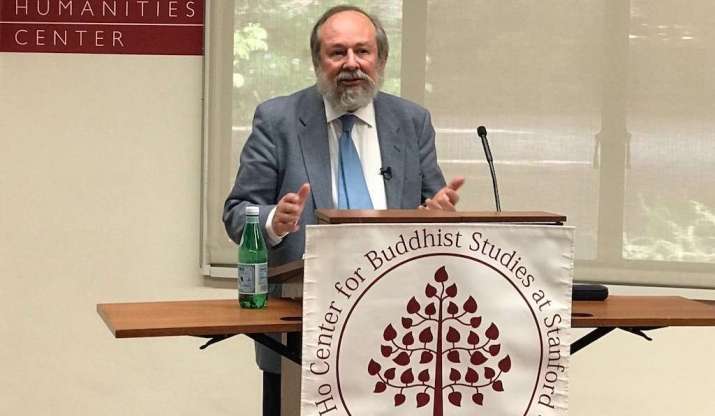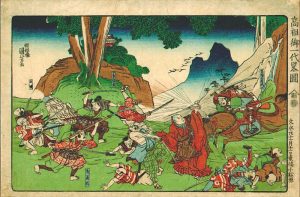Professor Emeritus T. H. Barrett is a veteran scholar of East Asian studies and Chinese religious history, and a specialist in the history of the British understanding of China. He earned his BA at Cambridge and PhD at Yale, and spent much of his academic career as a professor of East Asian History at London’s School of Oriental and African Studies. He is an academic staff member of the SOAS China Institute and the SOAS Japan Research Centre, as well as a member of the college’s Centre of Buddhist Studies.
Prof. Barrett was recently in Hong Kong and joined us for a sweeping and thorough conversation about scholarly engagement with China and its broader implications for how we see China in today’s volatile global environment.

Buddhistdoor Global: Can you share a little with us about your most recent projects?
Prof. T. H. Barrett: Since I retired, I’ve been doing work that I never had time to focus on before. There are two aspects of Chinese history that I have been looking at, the first of which is the development of the book, something Buddhism plays a major part in. The other thing I’ve been interested in is how Buddhism was a factor that linked China with the rest of Eurasia. What I’m doing here is part of a broader project, which is to see what sense of a wider world Buddhism brings to the Chinese way of life.
In Buddhist scriptures you’ll see the [Sanskrit] word “Jambudvipa,” which means the whole world in which we live. It’s clear that this word is much bigger than China. What I have been studying for some time is how this term occurs outside of the sutras as well, particularly in ritual documents in which you make a vow or commitment of some sort, like the bodhisattva vow. In these documents you will give your particulars, like your name and place of birth. You find that into the 19th century, many of these documents start with Jambudvipa, before listing China and then such-and-such a province, and so forth.
So although it appears that the international sense of Buddhism does disappear somewhat over the past millennium, in fact you can see that every Chinese Buddhist who was in the position of handling this kind of material would have been reminded that Buddhism is spread across much more than just China. This term remains in use right up until the 19th century, until we have a different sense of geography by the 20th and Jambudvipa disappears from modern Buddhist documents.
Another less common example: you will find in a couple of Chinese Buddhist sources—specifically translated travel accounts—that the Chinese emperor is referred to as just one of four great world rulers. He is called the “ruler of the massive population,” while there is a “ruler of the elephants” in India, “the ruler of the horses” who lives with the nomads on the steppe, and “the ruler of the jewels” in Persia. This is clearly an acknowledgement of a wider world.
Having looked at this very carefully, I hypothesize that whoever divided the world into four great rulers probably wasn’t a citizen from one of these four places. Most people tend to place their own culture as the prime or central kingdom. So who’s using this neutral political topography? I see them as the men in the middle, who came from places such as modern-day Tajikistan. Central Asia used to be inhabited by great trading peoples, some of whom believed in Buddhism, like the Sogdians and Bactrians. It seems to me that as a practical matter of knowledge that was useful to traders, it was helpful to have some knowledge of Asia’s cultural geography. This way of dividing up Asia can also be found in documents uncovered in Egypt.
BDG: This comes out of the Eurasian trade, then?
THB: Yes, Eurasian merchant knowledge that dates back to around 300 CE. It’s about the time when Buddhism is moving along the trade routes to China and the religion is already established, with new translators coming in. So this way of thinking about the world is something that Buddhism would have brought to China. Thanks to the Buddhist records, we have a way of looking at Eurasia in China that, unlike stereotypical understandings of how China saw the world, is pretty objective and sees other major civilizations as equals.
BDG: To my knowledge, Sinology has often been informed by the idea of China as a closed empire; isolationist and only influenced by foreign contact at various points. What is the current intellectual trend that you identify today?
THB: That’s a very interesting question. They say that all history is contemporary, and the view of China when I was a high school student or undergraduate would have been influenced by the fact that during the 1950s and 1960s, China was relatively isolated from the world. So there was a tendency to talk about this closed situation as a natural state of things, with the Great Wall being seen as representative of the isolationist instinct of Chinese culture. Scholars have reassessed this since the 1970s–80s onwards. The trend is very much to look at how China has interacted with the rest of the world, and it is particularly pertinent with the Belt and Road Initiative (BRI) today. China interacts much more with the world now than it did during the middle and end of the 20th century, and I think the way in which Buddhism was part of China’s international dynamic in the past deserves much more study.
BDG: Did Buddhism’s renowned cultural adaptability influence this interaction between the tradition and China?
THB: The attitude of Buddhism has always been one of respect for local traditions. Buddhism in India had to cope with popular belief in local spirits, so Buddhism has always taken a “two cultures” approach, whether in Japan or Myanmar or elsewhere. It was always able to accommodate deities holding dominion over nature and worldly concerns.
Buddhism deploys apologetics or polemics only when they see competitors claiming to be equal to their message of liberation or existential freedom. However, for the most part, the non-Buddhist aspects of the Chinese tradition are accepted as quite viable to a certain extent. This has consequences for how China and Buddhism understand co-existence and competition. For example, Buddhism sees as its unique purview universal liberation from samsara and extinguishing karmic consequences. But it maintains that to do good things and be a good person is helpful for your karma, and you don’t have to be a Buddhist to do that! It has quite a sophisticated view of how it co-exists with societies that may not be entirely Buddhist.
We could apply this to non-Buddhist spiritual traditions in China as well. I think the most basic category of spiritual understanding in China is the division of the world we can see and the world we can’t see. It’s a matter of recognizing authorities you can see and authorities that you can’t. The Confucian would say that there may well be unseen deities, but if you behave properly and be good, which is what a Confucian should do, you will be blessed either way!

BDG: In the study of religions, the word “religion” itself has been quite problematic for scholars. What do you think of the methodological limitations of this word in the Chinese context?
THB: I’m not a great fan of the word because it didn’t exist in China until the 19th century. The methodological dialogue really begins in Japan, where, unlike in China (where conflict with imperial powers centered on territorial or economic issues), the former persecutions of Christianity under the shogunate meant that when imperial powers asserted themselves in the 19th century, the Meiji intellectuals were concerned with notions of religious freedom and therefore needed a vocabulary to discuss these issues. In China, the earliest traces of “religion” in the Western sense seems to have begun in the 19th century when Protestant missionaries had to explain, in Chinese, how church and state functioned. How did the Papal States function? Who was the pope? He’s a religious figure, but what does that mean? That was, as it were, the arrival of the notion of religion in China—quite late.
You could write a history of religion in China, but conversely, why not write a history of ritual in Europe, and as such use a more Chinese category for European civilization? It would be refreshing but it wouldn’t be easy because that category was not the primary one that Europeans used to understand themselves.
BDG: How do academic institutions themselves shape the way China is studied and understood?
THB: We could contrast how British institutions functioned to, say, the French École française d’Extrême-Orient, which was originally based in Hanoi. The French were well ahead of the Brits when it came to sheer interest in East Asian culture and literature. One of my former colleagues said that the Brits wasted many opportunities and could have done a lot more if they had followed more of the French style. The University of Hong Kong in its early days was a slab of Britishness put down in East Asia. HKU’s Chinese Studies department was set up essentially at a time when China was modernizing very rapidly and some of Hong Kong’s prominent citizens felt that traditional Chinese culture was being neglected. What is distinct about Britain is the paradigm of economic advantage, which means that if you can make money out of it then nothing else matters. The intellectual curiosity does not go as far as the Europeans.
BDG: You’ve spent many years observing British academic engagement with China. What’s the current landscape?
THB: I’ve emphasized the commercial slant of the British study of the world because, sure, everybody wants to learn Mandarin and if you’re a vice-chancellor, you’ll say, “Gosh, we must have Chinese studies”—and the first thing you’ll do is have a course in Mandarin and business studies. I’ve heard more than one vice-chancellor say: “We don’t want any of that ‘old stuff!’ We want contemporary China! We want the real thing,” forgetting that part of China’s self-image is that it does have a very rich culture and history, and rightly so. To kind of ignore that is bizarre.
Part of it is because people of the age who have risen to the top of universities tend to be people who were young in the 1970s, and because of China’s situation back then—and history is contemporary—they assume that modern China has no connection to the older past. The aftermath of the Cultural Revolution told them that the past was finished, and they tended to believe that, perhaps unconsciously. It made life simpler, didn’t it? This notion hasn’t died, even though the study of traditional culture is now flourishing in China today.
BDG: Links to the past are now more important than ever in China and for the Belt and Road Initiative.
THB: The Silk Road thing intrigues me. Let me say something about that because it does relate back to Buddhism and the way Buddhism is connected to Eurasia. Because of the Cultural Revolution I couldn’t come to China to study Sinology and went to Japan instead. In the 1980s, you may recall, Japan was developing very rapidly and that prompted a good deal of reflection about its national uniqueness. Japanese would ask foreign friends what made their country so distinctive, and the foreigners were tempted to say, “You’re different because you spend all your time talking about what is different about you!”
Japan eventually ran out of steam, but back then it came to the point when it seemed that it would reach a point of global leadership where it wasn’t enough to simply say that the Japanese were different to everybody. I think the realization of difference went too far and there were attempts in certain circles to counter-emphasize how Japan had always been plugged in to the world. And the way to do that was to say that the Silk Road ended in Japan. Part of this was to do with tourism, but part of it was also this cultural sense that Japan has inherited a lot of Eurasian culture, and if you look at the seventh century treasures kept in the country you can see that this is true.
One way to look at the BRI is from an economic perspective, but by emphasizing connection, it is a way of saying, “We’ve always been part of something bigger,” that China has always been in contact with other cultures. We’re in the middle of it right now. It’s a process.
What I find intriguing is that Buddhism is a way of being both “of” and “out of” China. Buddhism clearly did take root in China; Chan Buddhism is itself a Chinese product. It seems to be able to reconcile this tension of national uniqueness and connective harmony. Buddhism has always been a transnational religion and one that has found its home in China. In terms of the cultural consequences of the way the world is going, Buddhism is right there. I think the way it’s all going to play out is going to be fascinating.












